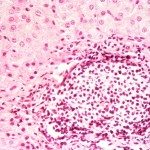Link to Pubmed [PMID] – 9150540
Vet. Pathol. 1997 Jan;34(1):8-14
Cutaneous papillomavirus infection was diagnosed in a 6-year-old female Boxer dog that was under long-term corticosteroid therapy for atopic dermatitis. Multiple black, rounded papules were present on the ventral skin. Spontaneous regression occurred within 3 weeks after cessation of corticosteroids. Histologically, the lesions consisted of well-demarcated cup-shaped foci of epidermal endophytic hyperplasia with marked parakeratosis. In the upper stratum spinosum and in the stratum granulosum, solitary or small collections of enlarged keratinocytes were observed with basophilic intranuclear inclusion bodies and a single eosinophilic fibrillar cytoplasmic inclusion. Ultrastructurally, viruslike particles (40-45 nm in diameter) were observed within the nucleus, free or aggregated in crystalline arrays. Undulating fibrillar material, thought to be a modified keratin protein, was observed in the cytoplasmic inclusion. Immunohistochemistry, restriction enzyme analysis, and molecular hybridization experiments indicated that these distinctive clinical, histologic, and cytologic features were associated with a novel canine papillomavirus.

